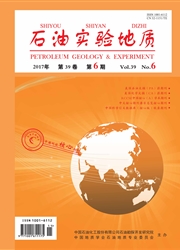

 中文摘要:
中文摘要:
塔北哈拉哈塘地区奥陶系多个层位均发育岩溶缝洞型储层。对钻井岩心系统采样测试分析,总结了哈拉哈塘地区不同地层的岩石类型及其纵向组合发育特征。不同类型碳酸盐岩溶蚀试验研究发现,泥质含量及Mg O含量对岩石可溶性具有影响,溶蚀强度为纯颗粒石灰岩〉〉白云质灰岩〉白云岩〉泥灰岩。以此为基础进行层组划分,将奥陶系碳酸盐岩划分为2类3型5个亚型:一间房组及鹰一、二段为灰岩连续型层组,属强岩溶层组;良一段,鹰三、四段为灰岩夹云岩亚型,岩溶强度属中等;其余各层组溶蚀性较弱。实际钻井结果及地震剖面"串珠"发育情况统计认为,该区岩溶层组类型控制了缝洞型储层的发育。
 英文摘要:
英文摘要:
Fractured and vuggy reservoirs were found in several Ordovician carbonate formations in the Halahatang area of the northern Tarim Basin. The lithology of different formations and their vertical distribution were studied based on microscopic observations and geochemical testing of core samples. Dissolution tests of different types of carbonates showed that the contents of argillaceous matter and Mg O could influence carbonate solubility. The intensity of dissolution decreased from pure limestones,dolomitic limestones,dolomites to muddy limestones. The Ordovician carbonates were classified into two classes,three types and five subtypes. The Yijianfang Formation and the first and second members of the Yingshan Formation are continuous limestones with strong karstification.The first member of the Lianglitage Formation and the third and fourth members of the Yingshan Formation are dolomitic limestones with medium karstification. The other formations were weakly karstified. Drilling results and the presence of "stringed beads"on seismic profiles indicated that the types of karst formation controlled the development of fractured and vuggy reservoirs.
 同期刊论文项目
同期刊论文项目
 同项目期刊论文
同项目期刊论文
 期刊信息
期刊信息
